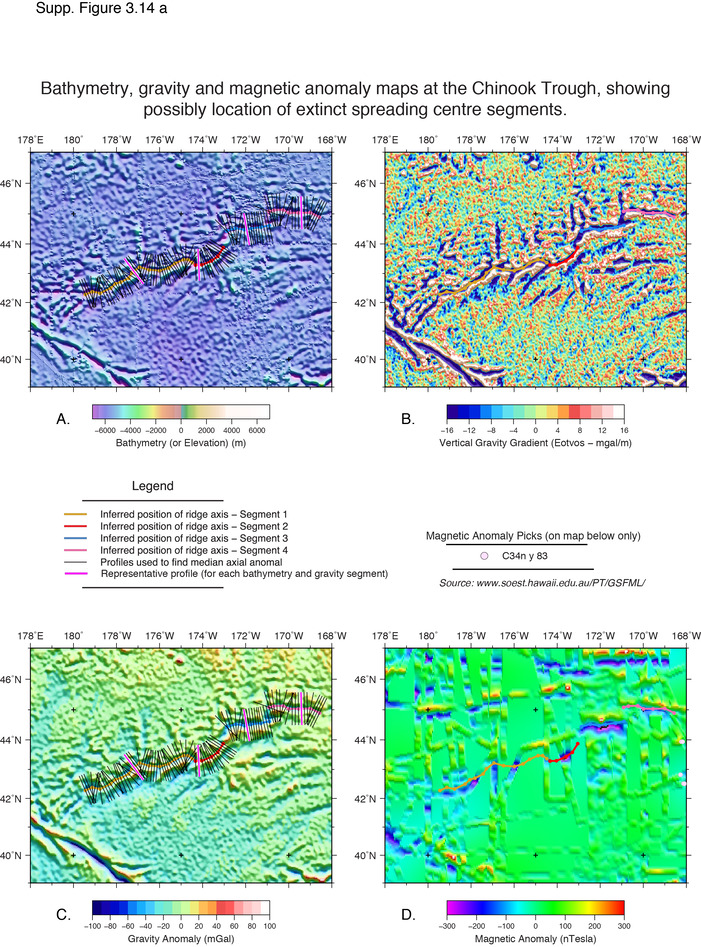| Ocean: | Pacific |
| Spreading center type: | Large-scale extinct MOR |
| Time of cessation: | Ca. 75Ma, chron C33 |
| Subsequent active spreading centre: | Pacific-Kula plate boundary (the Kula plate is proposed to have formed by fragmentation of the northern Farallon plate [Lonsdale, 1988]) |
| Cessation style: | Not constrained by available data |
| Later deformation or volcanism: | None evident |
Mammerickx and Sharman (1988) undertook a detailed study of the northwest Pacific ocean floor and suggested that the Chinook trough, an east-west trending feature of over 1000 km length, may have been a slow spreading centre prior to a major Pacific plate reorganization after chron C34. However, they observe that tectonic fabric either side of the trough are suggestive of very different spreading regimes (Mammerickx and Sharman, 1988). On the basis of the observed magnetic bight in the Mesozoic anomalies north west Pacific, Mammerickx and Sharman (1988) argue that two of the three probable active spreading-centres that met at a triple junction in this region were preserved in present-day crust at the time of their cessation. They propose that these were the Emperor Trough forming the Pacific-Farallon centre and the Chinook Trough, forming the Pacific-Kula plate boundary (Mammerickx and Sharman, 1988). Nakanishi et al. (1999), argue that the Shatsky hotspot may have been a significant influence on the triple-junction location through time and that there was a gradual north-eastern migration of the active spreading centre.
Atwater et al. (1993), essentially agree that oceanic spreading was likely to have occurred on the Chinook Trough prior to a major ridge reorganization and capture of the Kula plate. They state that the plate break up of Pacific plate at the ridge extinction “may have caused the C33 bend in Pacific-Farallon motion” (Atwater et al., 1993, p.148).
The Chinook Trough is a prominent bathymetric feature of almost 1000 km length, with relief of 1000-1500m and significant negative free-air gravity anomalies at axial segments. Both the form of the gravity anomalies and morphology of the trough are predominantly symmetrical, suggesting that the structure does not represent a large-scale fracture zone which would be expected to have one elevated flank. The absence of magnetic anomalies or absolute age constraints for the age of the oceanic crust either side of the trough prevents confirmation that this was an extinct ridge. The ocean floor to the south of the trough also has a more distinctive E-W fracture zone/abyssal hill pattern than the north. While there is some evidence that this structure may have been an extinct ridge it is possible that it is a large-scale crustal 'tear' that has resulted from ridge re-organizations or intraplate deformation, although the latter explanation is less likely. We consider that the Chinook Trough is a 'probable' extinct ridge.
Atwater, T.M. et al., 1993, Fracture zone traces across the North Pacific Cretaceous quiet zone and their tectonic implications. The Mesozoic Pacific: Geology, tectonics, and volcanism, v. 77, p. 137–154.
Lonsdale, P., 1988, Paleogene history of the Kula plate: Offshore evidence and onshore implications, Bulletin of the Geological Society of America, v. 100, p. 733–754.
Mammerickx, J. and Sharman, G.F., 1988. Tectonic evolution of the North Pacific during the Cretaceous quiet period, Journal of Geophysical Research, v. 93, p. 3009–3024.
Nakanishi, M., Sager, W.W. and Klaus, A., 1999, Magnetic lineations within Shatsky Rise, northwest Pacific Ocean: Implications for hot spot-triple junction interaction and oceanic plateau formation, Journal of Geophysical Research, v. 104, p. 7539.


